 The New Beetle has been around for several years now, and except for the classic shape, it’s not the Beetle of old. Unlike its ancestor, this New Beetle is conventional, modern and sophisticated. It has all of the bells and whistles of other current models, the performance and handling of a conventional front-wheel-drive car, and is still considered “charming.”
The New Beetle has been around for several years now, and except for the classic shape, it’s not the Beetle of old. Unlike its ancestor, this New Beetle is conventional, modern and sophisticated. It has all of the bells and whistles of other current models, the performance and handling of a conventional front-wheel-drive car, and is still considered “charming.”
One thing it does share with the original Beetle is popularity. The New Beetle sells quite well, and more and more of them are on the road. From baseline GL models to top-of-the-line turbo Cabriolets, there are versions to fit any desire. This article will focus on the various under-the-hood maintenance quirks that relate to this re-invented classic.
The basic vehicle layout is the same as the Golf and Jetta. Actually, the New Beetle chassis was here before the Series IV cars. The design is very conventional, with a strut suspension in front, and coil springs with separate shocks for the rear axle.
Engines and transmissions are VW standard units – 2.0L gas, 1.9L TDI and 1.8L turbo models. Be sure to always check for engine codes before ordering parts (see Photo 1), as there are many running changes that are not necessarily along model year lines.
There are different versions of each of these engines and some parts do not interchange 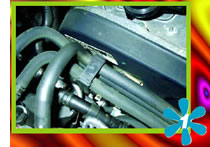 among them.
among them.
Note that there are airbags all over the interior, so be aware of their location before starting any disassembly procedures.
Sneak a Peek
After the covers are off, one look under the hood reveals that the layout is not too bad (see Photo 2.) On turbo models, for instance, the spark plugs are under the coil packs, which are under the collection of switches and hoses on the top of the engine. By removing a few screws, the bracket for these components flips out of the way and plug access and removal is fairly easy.
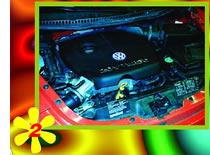 On early models, the coils are held in place with small bolts; later cars just have the coil packs seated in place with the rubber insulator. As with all VW models, make sure you are using only the recommended replacement parts to avoid comebacks.
On early models, the coils are held in place with small bolts; later cars just have the coil packs seated in place with the rubber insulator. As with all VW models, make sure you are using only the recommended replacement parts to avoid comebacks.
Bug Filter
One basic maintenance item that is more difficult on all New Beetle models is the air filter (see Photo 3). To prevent breaking the hose extending from the MAF sensor to the throttle body, open the spring clamp with locking pliers so the hose will rotate on the sensor to allow the filter box lid to twist up and out of the engine compartment. Be sure to disconnect the MAF wiring and, on early models, remove the one screw holding the silencer to the lid. It is also attached to the intake hose, making separation impossible, and prompting broken parts if it’s missed.
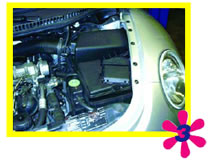 On models with secondary air pumps, you will also need to squeeze and release the air pump inlet hose at the filter lid.
On models with secondary air pumps, you will also need to squeeze and release the air pump inlet hose at the filter lid.
The reason I started with a simple item like the air filter is that it has to be removed, along with its base, to service a number of other things under the hood. After removing the first few, subsequent filters will come out easier. Under the filter housing, the brake master cylinder and reservoir, ABS unit, shifting mechanism and clutch hydraulics are accessible.
Beetle Belts
Timing belt replacement is the same as on other VW models, but due to the shape of the body, there are no good positions for a standard engine sling for supporting the engine to remove the right side mount.
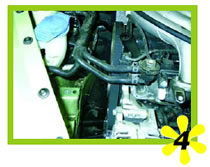 In Photo 4, you can see how tight the clearance is for belt removal. After the mounts are removed (see Photo 5), with the engine supported from underneath, there is plenty of space to remove the belt, tensioner and water pump (see Photo 6).
In Photo 4, you can see how tight the clearance is for belt removal. After the mounts are removed (see Photo 5), with the engine supported from underneath, there is plenty of space to remove the belt, tensioner and water pump (see Photo 6).
With the engine supported, and mount parts removed, slide the old belt off and the new belt on. Then you can reinstall the mount and complete the repair.
The timing belt drives the water pump on all New Beetle engines. Close examination or even removal is recommended to ensure that it is working properly and not leaking. Most of the factory pumps are equipped with a plastic impeller that often fails and is difficult to diagnose. My advice is to remove and inspect it any time the belt is off and replace it if the car has more than 60,000 miles on the odometer, or if there are any signs of leakage.
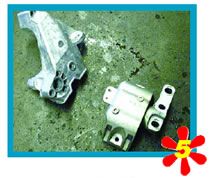 From the condition of the belts I’ve been seeing, I wouldn’t stretch the replacement interval for the timing belt past a maximum of 80,000 miles.
From the condition of the belts I’ve been seeing, I wouldn’t stretch the replacement interval for the timing belt past a maximum of 80,000 miles.
Here in the Seattle area, cars tend to do a lot of idle time, and that just adds wear time to the belt. All of the engines are potential interference candidates, especially TDI and turbo models.
Beetle Juice
Note: The plastic coolant flange at the end of the cylinder head leaks on these cars like other models. So look for coolant pooled on top of the transaxle.
The flange is shaped differently on New Beetles (see Photo 7) and 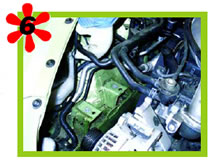 access is a little more involved.
access is a little more involved.
Inspecting Beetle Emissions
Though not exclusive to the New Beetle, check engine light episodes are a daily fact of life for a lot of cars. The restricted size of the New Beetle engine compartment makes for some common faults. For many episodes, especially concerning the secondary air pump system or tank purge system problems, a close examination of vacuum hoses is often all that’s needed.
Look closely at the hoses that run to the back of the engine. The heat in this area is excessive due to the body configuration, and the hoses tend to crumble. I’ve been using with success a high-temperature BMW hose to replace the OE hose for lasting repairs. We’ve also seen a few failures of the 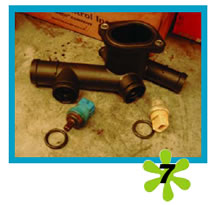 purge solenoid, and its location may be a mystery without a manual. It’s mounted behind the coolant and washer reservoirs on the inner right front fender.
purge solenoid, and its location may be a mystery without a manual. It’s mounted behind the coolant and washer reservoirs on the inner right front fender.
Be aware that some early OBD II cars won’t set codes for the MAF sensor. If you get ongoing codes for fuel trim, or symptoms like loss of power or hard starting, the MAF sensor is a likely problem. With a proper scanner you can also access and run activations to check individual components for operation.
This method is especially helpful when testing the secondary air system. If the pump is noisy or inoperative, it will be very obvious.
Glow Bug
On TDI (diesel) engines, the glow plug circuit has had some problems. If you get codes for glow plug resistance or failure, but the glow plugs individually test OK , there is a fix that we have used with success many times. It involves replacing the rubber-covered glow plug buss with a new one.
It seems there was a problem with internal breakdown of this buss and, because it’s a covered connector, the breakdown is not obvious from the outside.
The replacement buss will come with two spade connectors and a short pigtail. Cut the connectors off, as well as the original buss, and solder the new buss into place. Make sure you cover the connections with shrink tube and tape to protect the harness from contacting the engine.
Beetle OBD Fixes
The following are more common Check Engine Light failures that we continue to see and how we resolved them. As always, throwing parts at a problem is not the best tool for OBD repairs. Knowing how a component is designed to work is always the first step in locating a failure.
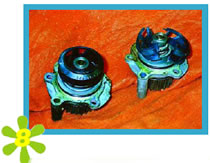 Whatever the reason for the MIL to be on, there was a sequence of events that lead the ECM to conclude there was a problem. A visual inspection should always be the first step in any diagnostic procedure. After pulling codes in the case of an OBD failure, a look at the system involved just might turn up an obvious fault without any test equipment.
Whatever the reason for the MIL to be on, there was a sequence of events that lead the ECM to conclude there was a problem. A visual inspection should always be the first step in any diagnostic procedure. After pulling codes in the case of an OBD failure, a look at the system involved just might turn up an obvious fault without any test equipment.
DTC P0116, 117, 118, 125 — Engine Coolant Temp Sensor (ECT) out of range: This set of codes is almost always accompanied by a report of overheating. The most common cause is water pump failure (see Photo 8). Start by looking for obvious coolant leaks, low coolant level or other signs of overheating. Certainly check the ECT for resistance values; replace if it’s out of specification. If the coolant level is low, determine the source of leakage and repair. If there are symptoms of high engine heat when driving, but the temperature is OK at idle, the most likely candidate is the water pump.
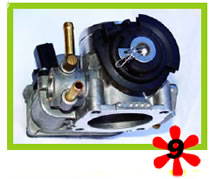 DTC P0120, 121, 122, 221, 507 and more — Throttle Control Module faults: Probably the most common cause of these faults is tampering. For most VW models after 1996, the throttle angle is controlled electronically. The cable going to the throttle body is for cruise control, not throttle operation. Throttle angle is calculated by the ECM reading the angle at the pedal position sensor, vehicle speed, gear position and other factors. Simply opening the throttle by hand under the hood with the engine running can cause codes to set. Most often, the cause is an attempt to change idle speed by changing the base setting of the throttle plate, either by adjusting the stop screw or adding a shim to hold the cable linkage from closing (see Photo 9).
DTC P0120, 121, 122, 221, 507 and more — Throttle Control Module faults: Probably the most common cause of these faults is tampering. For most VW models after 1996, the throttle angle is controlled electronically. The cable going to the throttle body is for cruise control, not throttle operation. Throttle angle is calculated by the ECM reading the angle at the pedal position sensor, vehicle speed, gear position and other factors. Simply opening the throttle by hand under the hood with the engine running can cause codes to set. Most often, the cause is an attempt to change idle speed by changing the base setting of the throttle plate, either by adjusting the stop screw or adding a shim to hold the cable linkage from closing (see Photo 9).
After determining the extent of the tampering, you will need to perform a throttle valve control module (TVCM) adaption procedure to synchronize the throttle to the pedal position sensor. Many models do this automatically if the key is turned on without starting for 10 seconds. Cars with automatic transmissions also need to have the transmission control module basic setting procedure done any time the throttle control module is adapted.
If the TVCM adaption cannot be completed after several attempts, and a thorough cleaning of the throttle body, the only solution may involve replacement of the throttle control module — an expensive part. The factory adjustments could probably be repeated, if all you have is a lot of free time. Make sure all other basics, such as vacuum leaks and mechanical faults that could have caused the tampering attempt, are resolved before taking this step.
DTC P0411 – Secondary Air Injection System incorrect flow detected: This code comes up almost daily. The typical cause is the failure of the vacuum hose to the check valve (combivalve) on the exhaust manifold. Just like EGR vacuum hoses have cracked and fallen off for years, this hose lives in a harsh environment not meant for rubber hose covered with cloth.
Here’s the diagnostic procedure for the P0411 code.
1. Start the cold engine and listen for the “vacuum cleaner” sound of the secondary air pump. The pump should run for up to 100 seconds during any cold start, and may run even after a warm start or after an extended idle.
2. If the pump runs, isn’t too noisy and shuts off after a couple of minutes, start tracing the hoses from and to the pump, and locate the check valve.
3. Inspect the small hose to the valve. Just touching it at the valve connection will usually verify the failure (the valve may be a little warm!).
4. If the hose has failed, replace it, preferably with a silicone hose of the correct size to prevent leakage and repeat failure.
5. With your scanner set to activations, run the pump relay, pump and control valve tests. Use a vacuum pump to make sure the check valve is not damaged (stuck open or closed).
6. If the pump is excessively noisy (experience is the best determining factor; they all make some noise), inspect the inlet hose for any signs of water entry. This is especially troublesome on models that have the pump mounted low in the engine compartment and draw air from the air cleaner. Like a vacuum cleaner, water getting into the pump will kill it in short order. The pump can also be damaged by exhaust getting past a stuck check valve. Always determine the cause of the pump failure before replacement, so the new pump isn’t immediately damaged.
DTC P0440, 441, 1410, 1425, 1426 — EVAP faults: This is an obvious one for all cars. The first step is to always go to the fuel filler and check for a missing or incorrectly installed cap. It’s amazing to me that there are people who still don’t know about making the cap “click” when installing. A cap tester should be used next whenever there is not an obvious “operator error.” At this point, probably more than 90% of EVAP faults should be resolved.
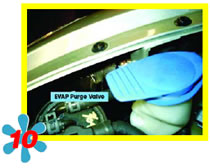 The next step with VAG cars is to get the scanner out and test operation of the canister purge valve (see Photo 10) through the activation function. This valve is usually buried in the passenger side of the engine compartment, so this is the easiest way to check to see if it works. If the valve is working, clear the code and take the car on a test drive; if the code doesn’t reset, you’re finished. If it does reset, there may still be a leak, so get your smoke machine out and start pumping the system full of smoke and repair any leaks as needed. The place to look on most models up to 1999 is the collection of hoses near the passenger side of the engine compartment. These hoses are often not clipped into place and rub through on the accessory belt.
The next step with VAG cars is to get the scanner out and test operation of the canister purge valve (see Photo 10) through the activation function. This valve is usually buried in the passenger side of the engine compartment, so this is the easiest way to check to see if it works. If the valve is working, clear the code and take the car on a test drive; if the code doesn’t reset, you’re finished. If it does reset, there may still be a leak, so get your smoke machine out and start pumping the system full of smoke and repair any leaks as needed. The place to look on most models up to 1999 is the collection of hoses near the passenger side of the engine compartment. These hoses are often not clipped into place and rub through on the accessory belt.
VW ends all of its diagnostic and repair procedures with a “Test Drive Re-Learn Procedure.” This can be accomplished in several ways. You can use your scanner, from a cold start and go through a step-by-step process to set basic settings, readiness codes and then check for any recurring codes. You can also take the car on a road trip, completing a designated drive cycle, and then recheck for codes. Or you can return the car to the customer with this advice: The car will need to be driven from a cold start for a minimum of 1 hour, or 50 miles, varying the speed and throttle angle, without turning off the ignition.
Beetle Mania
Before getting into the specifics, I have a couple of recommendations.
One, check your service information database to see how much New Beetle specific information is available. If information is lacking, get a New Beetle-specific manual as a reference.
Two, if the customer has the owner’s manual, spend a little time reading it to get great information, including answers on how some items are supposed to work.
Three, there are a lot of plastic parts on these cars (including the fenders, hood and deck lid) so care will be needed to prevent breakage.
Four, these cars will be around for a long time, so learn how to work on them; it just gets easier.
Did You Know…
None of the New Beetle models uses a conventional distributor, relying instead on DIS or coil-on-plug designs.
What’s a “P” Code?
“P” codes relate to Powertrain control malfunctions. DTCs that start with P0 are federally mandated control parameters, and should be accessible with any scanner, but may provide only basic interpretation and may not be much help other than pointing you in a general direction for diagnosis. DTCs starting with P1 are manufacturer-specific codes that may not always be interpreted by a generic scanner. From there, the numbers narrow the scope of the DTC to a particular control parameter, and then a specific component. Volkswagen cars can also have five-number, VW-specific DTCs that have no OBD II match. This is why having a scanner that can access VW-specific information can be a time saver if you work on many of these vehicles.
Did You Know…
Engine maintenance items on the New Beetle are the same as the other VW models. You’ll need a spark plug boot remover for 2.0L models, and a cap wrench for the oil filter on TDI engines.


